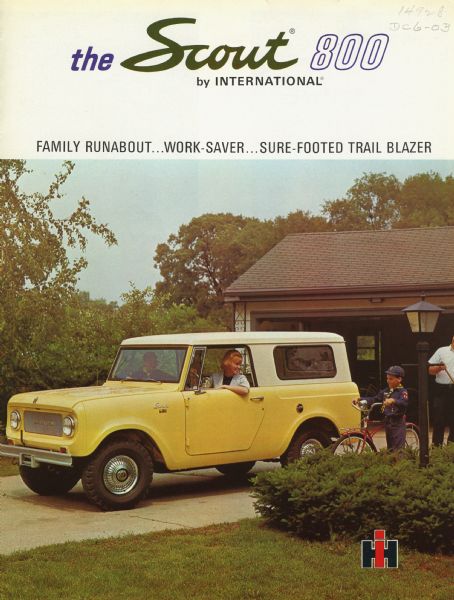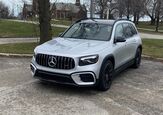Rare Rides: The International Harvester Scout, Not a Jeep (Part I)

Today’s Rare Ride is the fourth International Harvester product featured in this series, after a 1200 D, Travelall, and the 2000s era (and ridiculous) MXT personal semi-truck.
Let’s pay a visit to Scout (the first one).
Like the Travelall previously featured, the Scout was an early example of what would later be known as a sport utility vehicle. The Travelall entered production in 1953, but later in the decade, IH saw an additional opportunity for a smaller and more off-road focused truck. This new entry would rival the successful Jeep CJ. It was a new market segment: a recreational four-wheel drive vehicle; one not used strictly for work like in the past.
Late in 1960 for the 1961 model year, International debuted the Scout 80. Available as a truck with a removable cap or with a full-length removable roof, the Scout offered much two-door flexibility. The initial run of Scout 80s was from 1960 to 1965 and put the Scout into the American public’s consciousness as an off-road vehicle. Bare bones at this time like all proto-SUVs, rear seats were not even available in the Scout 80. The windshield folded down though, to let the insects gently tap one’s face while on the move.
During the ’65 model year, the 80 was upgraded to the 800. International focused on the improvement of passenger comfort, additional amenities, and more power. The 800 had a better heating system, a revised dashboard with improved instruments, and crucially, an optional rear seat. That meant a family might actually be able to use an 800 as an everyday car. The 800 series saw the base 2.5-liter (93 HP) of the 80 supplemented with an optional turbocharged version (111 HP), as well as a 3.8-liter inline-six, and 4.4-liter V8.
By late 1968 the 800 morphed into the 800A, which again improved comfort and added amenities. Added to the engine lineup was the optional 5.0-liter 304 V8. The 800A ran only from November 1968 through August 1970 before it was replaced by the 800B, officially the last first-gen Scout. 800Bs were made from August of ’70 through March of ’71, the 800B was mostly a filler model until the Scout II was ready to enter production. Notably, the Comanche trim package appeared and made the 800B look as fancy as possible.
Throughout the Scout’s run, there were numerous options packages and individual trim items that could for the most part be ordered independently. For example, the flip-down windshield was still available on the Scout 800 but was not often optioned because it was not advertised. Trim, engines, roof styles, Scouts were built in a hodgepodge of combinations. Add in the fact that International tended to grab parts from various suppliers all the time, and you end up with an artisanal-type run of trucks. But it was time to move on to bigger and better things, and by 1970 the SUV market was heating up.
In Part II we’ll suitably cover the other Scout, the II.
[Images: International Harvester]

Interested in lots of cars and their various historical contexts. Started writing articles for TTAC in late 2016, when my first posts were QOTDs. From there I started a few new series like Rare Rides, Buy/Drive/Burn, Abandoned History, and most recently Rare Rides Icons. Operating from a home base in Cincinnati, Ohio, a relative auto journalist dead zone. Many of my articles are prompted by something I'll see on social media that sparks my interest and causes me to research. Finding articles and information from the early days of the internet and beyond that covers the little details lost to time: trim packages, color and wheel choices, interior fabrics. Beyond those, I'm fascinated by automotive industry experiments, both failures and successes. Lately I've taken an interest in AI, and generating "what if" type images for car models long dead. Reincarnating a modern Toyota Paseo, Lincoln Mark IX, or Isuzu Trooper through a text prompt is fun. Fun to post them on Twitter too, and watch people overreact. To that end, the social media I use most is Twitter, @CoreyLewis86. I also contribute pieces for Forbes Wheels and Forbes Home.
More by Corey Lewis
Latest Car Reviews
Read moreLatest Product Reviews
Read moreRecent Comments
- Michael Gallagher I agree to a certain extent but I go back to the car SUV transition. People began to buy SUVs because they were supposedly safer because of their larger size when pitted against a regular car. As more SUVs crowded the road that safety advantage began to dwindle as it became more likely to hit an equally sized SUV. Now there is no safety advantage at all.
- Probert The new EV9 is even bigger - a true monument of a personal transportation device. Not my thing, but credit where credit is due - impressive. The interior is bigger than my house and much nicer with 2 rows of lounge seats and 3rd for the plebes. 0-60 in 4.5 seconds, around 300miles of range, and an e-mpg of 80 (90 for the 2wd). What a world.
- Ajla "Like showroom" is a lame description but he seems negotiable on the price and at least from what the two pictures show I've dealt with worse. But, I'm not interested in something with the Devil's configuration.
- Tassos Jong-iL I really like the C-Class, it reminds me of some trips to Russia to visit Dear Friend VladdyPoo.
- ToolGuy New Hampshire





































Comments
Join the conversation
Really enjoy this series and all Corey's series. Corey's and Murilee's posts are the main reason I still come back to this site.
G-rated (safe for work) video of a recently-exhumed 1964 Scout (delete XX to view): XXhttps://www.youtube.com/watch?v=V_I7xEY-t2M